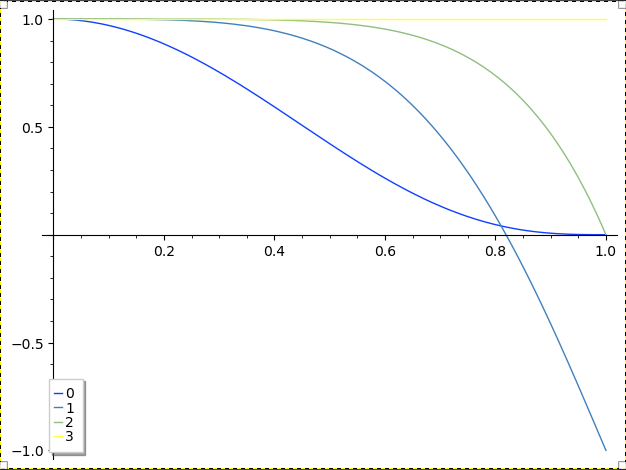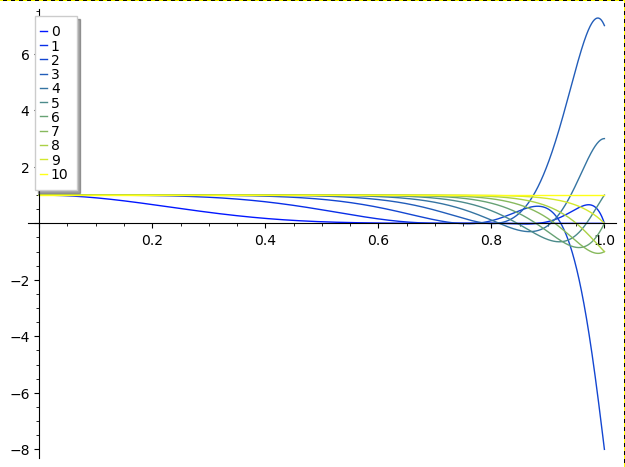Let us compute and plot the functions of the parameter $a$ defined as the determinants of the matrices $A_0$, $A_1$, $A_2$, $A_3$:
$$
\begin{aligned}
\det A_0 &=
\begin{vmatrix}1&a&a^2&a^3\\a&1&a&a^2\\a^2&a&1&a\\a^3&a^2&a&1\end{vmatrix}
= 1-3a^2+3a^4-a^6=(1-a)^3(1+a)^3
\ ,\\[2mm]
\det A_1 &=
\begin{vmatrix}1&0&a^2&a^3\\0&1&0&a^2\\a^2&0&1&0\\a^3&a^2&0&1\end{vmatrix}
= 1-2a^4+a^8-a^6 =(1-a^3-a^4)(1+a^3-a^4)
\ ,\\[2mm]
\det A_2 &=
\begin{vmatrix}1&0&0&a^3\\0&1&0&0\\0&0&1&0\\a^3&0&0&1\end{vmatrix}
= 1-a^6=(1-a)(1+a)(1-a+a^2)(1+a+a^2)
\ ,\\[2mm]
\det A_3 &=
\begin{vmatrix}1&0&0&0\\0&1&0&0\\0&0&1&0\\0&0&0&1\end{vmatrix}
=1
\ .
\end{aligned}
$$
A plot of these functions of $a\in(0,1)$ is:

So the claimed inequality $(1-a^2)^3=\det A_0(a)\le \det A_1(a)\le\det A_2(a)\le \det A_3(a)=1$ is valid for $n=4$ only in some neighborhood of zero.
Alternatively, let us consider the case $n=11$.

So let us consider only the functions in a neighborhood of zero.
In $a=0$ all determinants of the $n\times n$-matrices $A_j(a)$ are one.
Then it is enough to figure out the first non-trivial term in $a,a^2,a^3,\dots$ in the Taylor expansion of $\det A_j(a)$, $j$ running from $0$ to $n-1$. It turns out that we have:
$$\tag{$\dagger$}$$
$$
\begin{aligned}
\det A_0(a) &= 1 -(n-1)a^2 + O(a^4)\ ,\\
\det A_1(a) &= 1 -(n-2)a^4 + O(a^6)\ ,\\
\det A_2(a) &= 1 -(n-3)a^6 + O(a^8)\ ,\\
&\text{ and so on }\\
\det A_{j-1}(a) &= 1 -(n-j)a^{2j} + O(a^{2(j+1)})\ ,\\
&\text{ till finally we have}\\
\det A_{n-2}(a) &= 1-a^{2(n-1)}\ ,\\
\det A_{n-1}(a) &= 1\ .
\end{aligned}
$$
To see this, consider the matrix $A_{j-1}(a)$,
$$
A_{j-1}(a)=
\begin{bmatrix}
1 &0&0&\dots&0&a^j&a^{j+1}&\dots\\
0&1 &0&0&\dots&0&a^j&\ddots\\
0&0&1 &0&0&\dots&0&\ddots\\
\vdots&0&0&1&0&0&0&\ddots\\
0&\vdots&0&0&1&0&0&\ddots\\
a^j&0&\vdots&0&0&1&0&\ddots\\
a^{j+1}&a^j&0&\vdots&0&0&1&\ddots\\
\vdots&\ddots&\ddots&\ddots&\ddots&\ddots&\ddots&\ddots\\
\end{bmatrix}
$$
Its determinant is a sum of terms corresponding to permutations in the symmetric group $S(n)$ with $n!$ elements. Excepting $1$ (corresponding to the trivial permutation), there is no term in degree $<2j$. To obtain terms in degree $a^{2j}$ we need a permutation that takes from each row (column) a non-zero entry, and two of these entries are $a^j$, all other must be diagonal ones. So it is a transposition, one among $(1,j+1)$, $(2,j+2)$, ... $(n-j,n)$. And there is no chance to produce $(\pm 1)^{n-2}\cdot a^j\cdot a^{j+1}$ using other permutations. This shows $(\dagger)$.
$\square$
Sage code used to produce the graphs:
def A(n, k, a):
return matrix(n, n, [ 0 if j != jj and abs(j-jj) <= k
else a^abs(j-jj)
for j in range(n) for jj in range(n)])
def mygraphs(N):
P = plot([])
for j in range(N):
P += plot( lambda s: A(N, j, s).det() , (0, 1)
, color=((j+1)^2/N^2, (j+1)/N, 1-j/N)
, legend_label=f'{j}' )
return P
mygraphs(4)
mygraphs(11)


